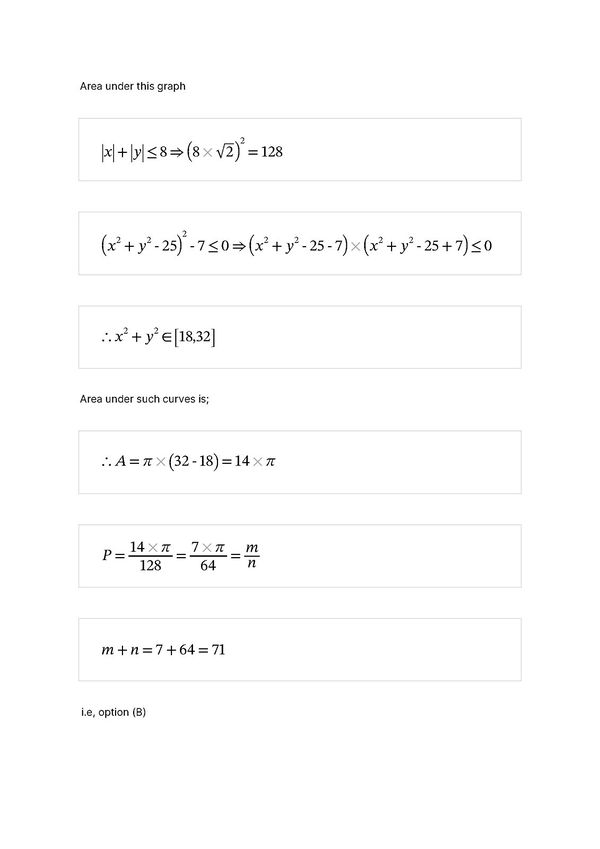Difference between revisions of "2024 AMC 10B Problems/Problem 14"
(→Solution 2 (Calculus)) |
|||
| Line 58: | Line 58: | ||
Expressing the Area of Region | Expressing the Area of Region | ||
| − | Region | + | Region |
| − | + | ||
| − | |||
| − | |||
In each quadrant, this can be expressed by the following functions: | In each quadrant, this can be expressed by the following functions: | ||
| − | + | First quadrant: | |
| − | + | Second quadrant: | |
| − | + | Third quadrant: | |
| − | + | Fourth quadrant: | |
In the first quadrant, | In the first quadrant, | ||
Revision as of 00:16, 15 November 2024
- The following problem is from both the 2024 AMC 10B #14 and 2024 AMC 12B #9, so both problems redirect to this page.
Contents
[hide]Problem
A dartboard is the region B in the coordinate plane consisting of points ![]() such that
such that ![]() . A target T is the region where
. A target T is the region where ![]() . A dart is thrown at a random point in B. The probability that the dart lands in T can be expressed as
. A dart is thrown at a random point in B. The probability that the dart lands in T can be expressed as ![]() , where
, where ![]() and
and ![]() are relatively prime positive integers. What is
are relatively prime positive integers. What is ![]() ?
?
![]()
Diagram
![[asy] // By Elephant200 // Feel free to adjust the code size(10cm); pair A = (8, 0); pair B = (0, 8); pair C = (-8, 0); pair D = (0, -8); draw(A--B--C--D--cycle, linewidth(1.5)); label("$(8,0)$", A, NE); label("$(0,8)$", B, NE); label("$(-8,0)$", C, NW); label("$(0,-8)$", D, SE); filldraw(circle((0,0),4*sqrt(2)), gray, linewidth(1.5)); filldraw(circle((0,0),3*sqrt(2)), white, linewidth(1.5)); draw((-10, 0)--(10,0),EndArrow(5)); draw((10, 0)--(-10,0),EndArrow(5)); draw((0,-10)--(0,10), EndArrow(5)); draw((0,10)--(0,-10),EndArrow(5)); [/asy]](http://latex.artofproblemsolving.com/0/3/3/033f5ec7de3fd0710af486d82a9cfbd5cad11a1c.png) ~Elephant200
~Elephant200
Solution 1
Inequalities of the form ![]() are well-known and correspond to a square in space with centre at origin and vertices at
are well-known and correspond to a square in space with centre at origin and vertices at ![]() ,
, ![]() ,
, ![]() ,
, ![]() .
The diagonal length of this square is clearly
.
The diagonal length of this square is clearly ![]() , so it has an area of
, so it has an area of
![]() Now,
Now,
![]() Converting to polar form,
Converting to polar form,
![]() and
and
![]()
The union of these inequalities is the circular region ![]() for which every circle in
for which every circle in ![]() has a radius between
has a radius between ![]() and
and ![]() , inclusive. The area of such a region is thus
, inclusive. The area of such a region is thus ![]() The requested probability is therefore
The requested probability is therefore ![]() yielding
yielding ![]() We have
We have ![]()
-anonymous, countmath1
Solution 2 (Calculus)
Expressing the Area of Region
Region
In each quadrant, this can be expressed by the following functions:
First quadrant:
In the first quadrant, ![]()
![]()
![]() The total area of region
The total area of region ![]()
Expressing the Area of Region ![]()
To find the area, we switch to polar coordinates with
The area of ![]()
![\[= \int_0^{2\pi} \left[ \frac{r^2}{2} \right]_{r=\sqrt{18}}^{r=\sqrt{32}} \, d\theta = \int_0^{2\pi} \left( \frac{32}{2} - \frac{18}{2} \right) \, d\theta\]](http://latex.artofproblemsolving.com/7/0/e/70e70fea1b687b29957e9595e4b1fc6a479f80f5.png)
![]()
The probability ![]()
So the probability is of the form
![]()
Video Solution 1 by Pi Academy (Fast and Easy ⚡🚀)
https://youtu.be/YqKmvSR1Ckk?feature=shared
~ Pi Academy
Video Solution 2 by SpreadTheMathLove
https://www.youtube.com/watch?v=24EZaeAThuE
Solution 2
~Kathan
See also
| 2024 AMC 10B (Problems • Answer Key • Resources) | ||
| Preceded by Problem 13 |
Followed by Problem 15 | |
| 1 • 2 • 3 • 4 • 5 • 6 • 7 • 8 • 9 • 10 • 11 • 12 • 13 • 14 • 15 • 16 • 17 • 18 • 19 • 20 • 21 • 22 • 23 • 24 • 25 | ||
| All AMC 10 Problems and Solutions | ||
| 2024 AMC 12B (Problems • Answer Key • Resources) | |
| Preceded by Problem 8 |
Followed by Problem 10 |
| 1 • 2 • 3 • 4 • 5 • 6 • 7 • 8 • 9 • 10 • 11 • 12 • 13 • 14 • 15 • 16 • 17 • 18 • 19 • 20 • 21 • 22 • 23 • 24 • 25 | |
| All AMC 12 Problems and Solutions | |
The problems on this page are copyrighted by the Mathematical Association of America's American Mathematics Competitions. 










